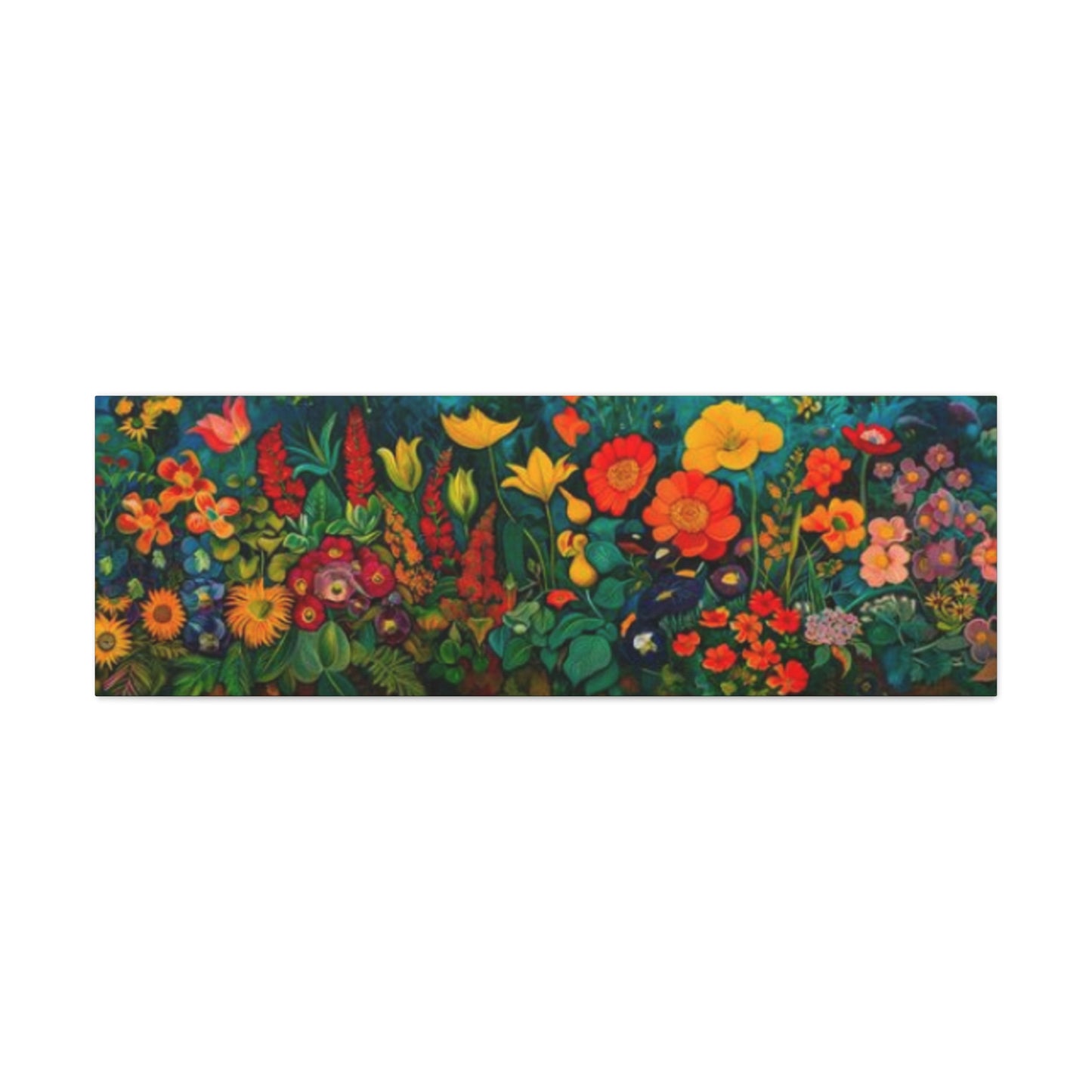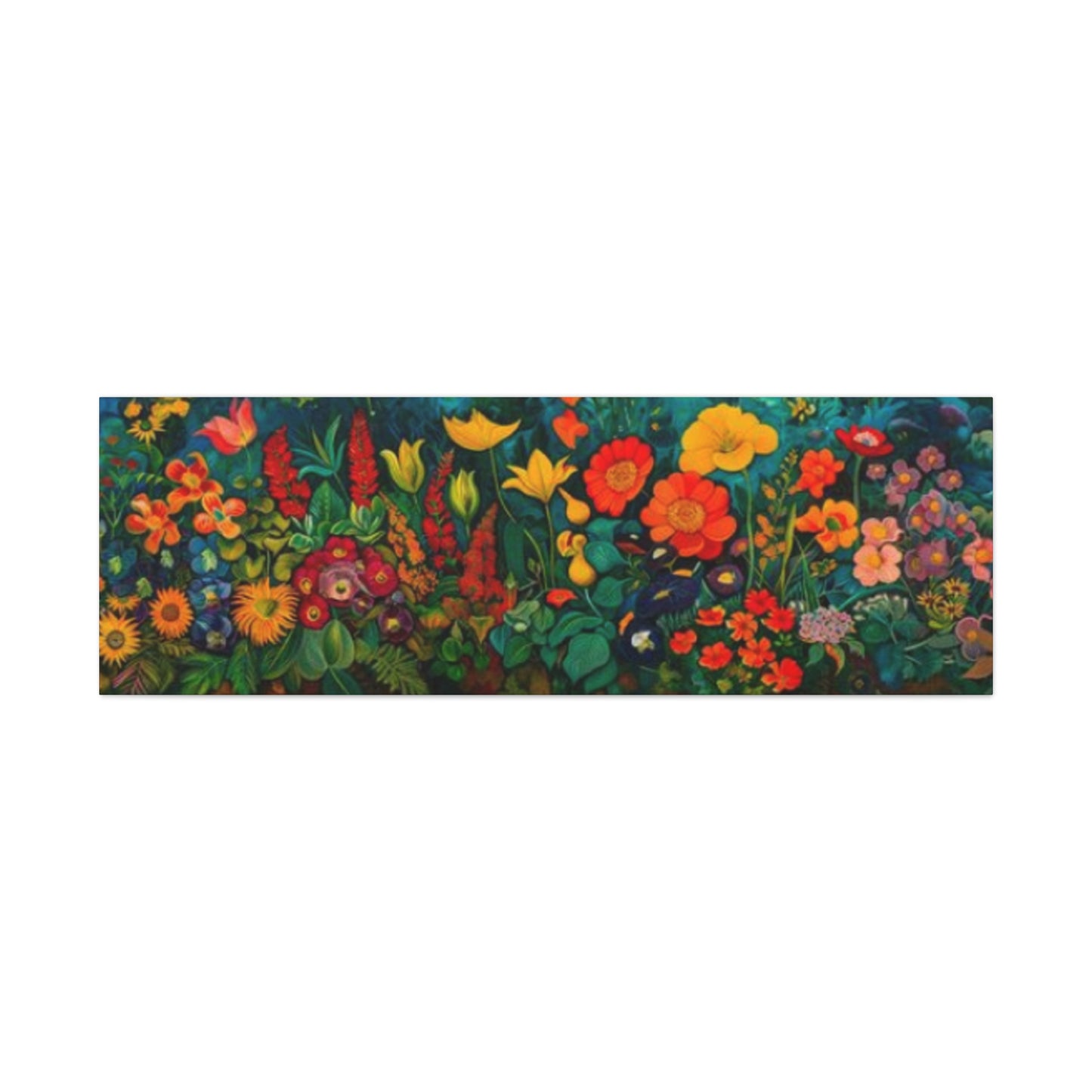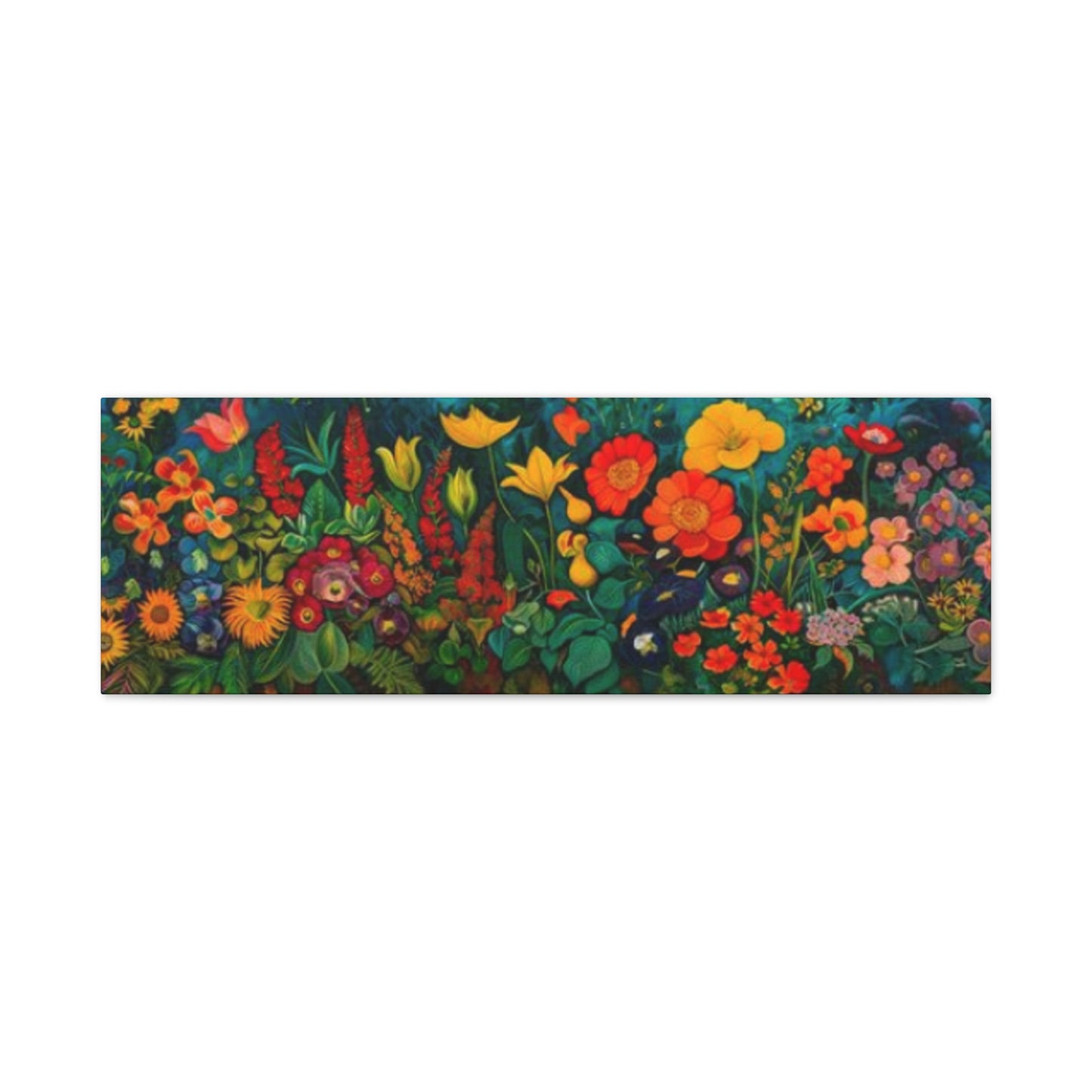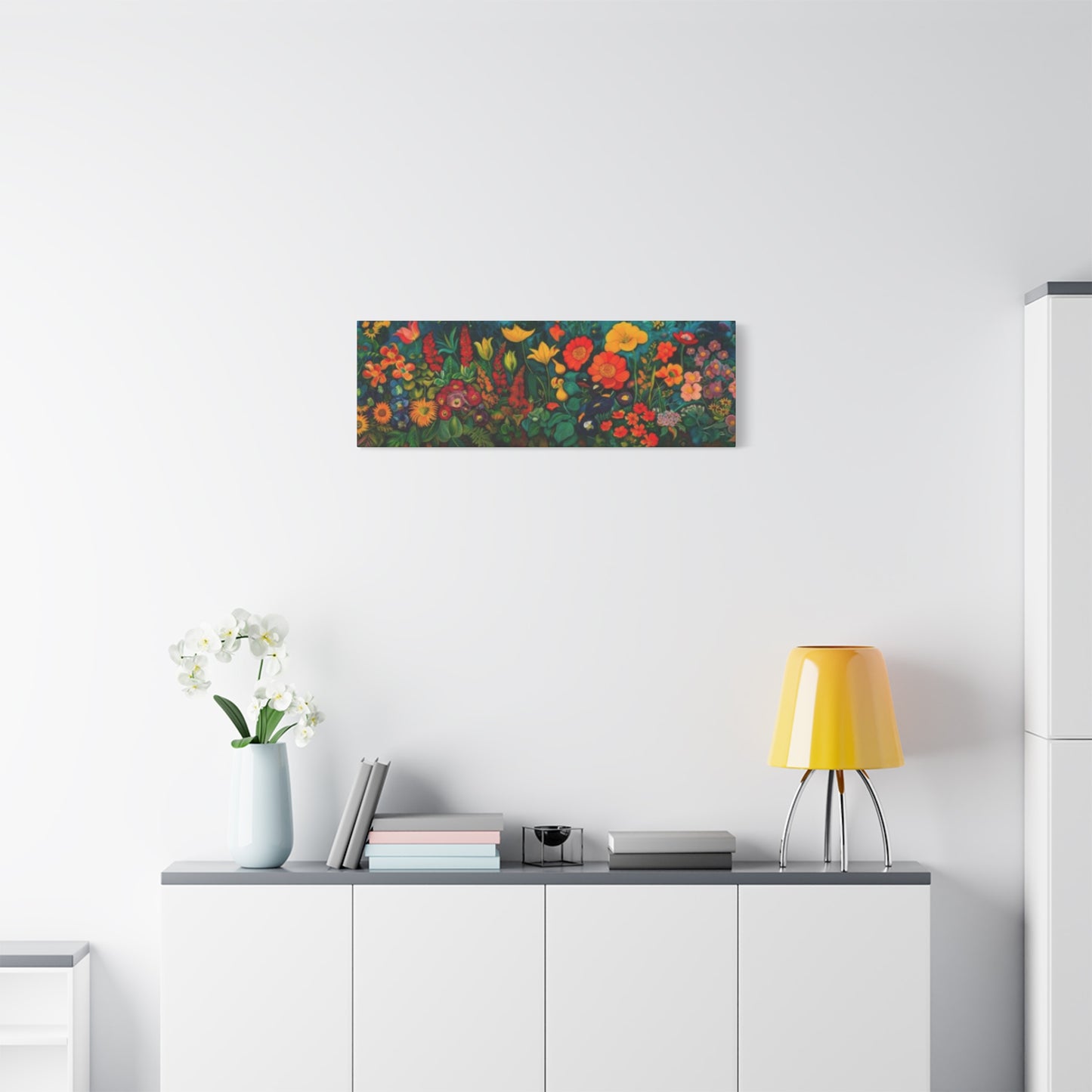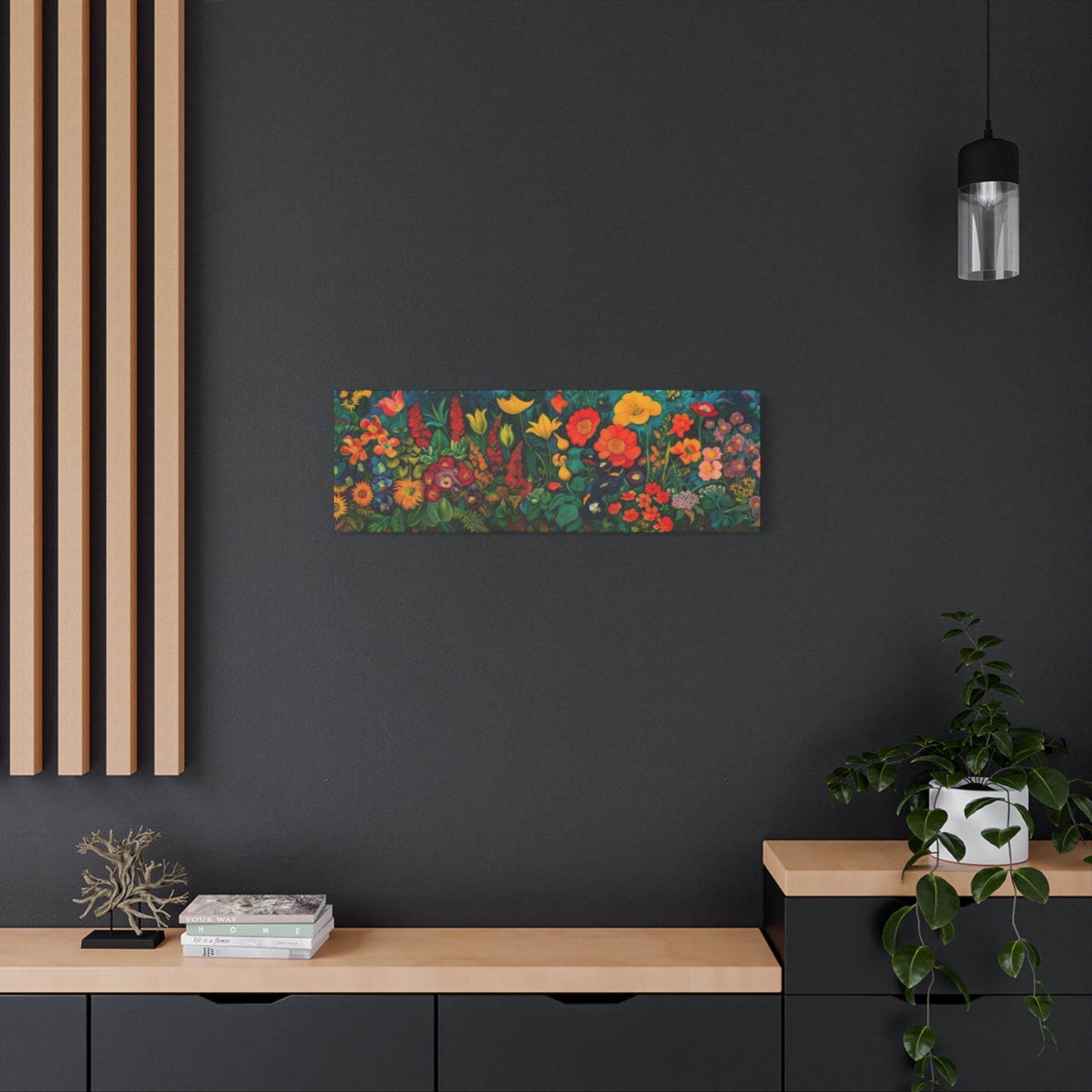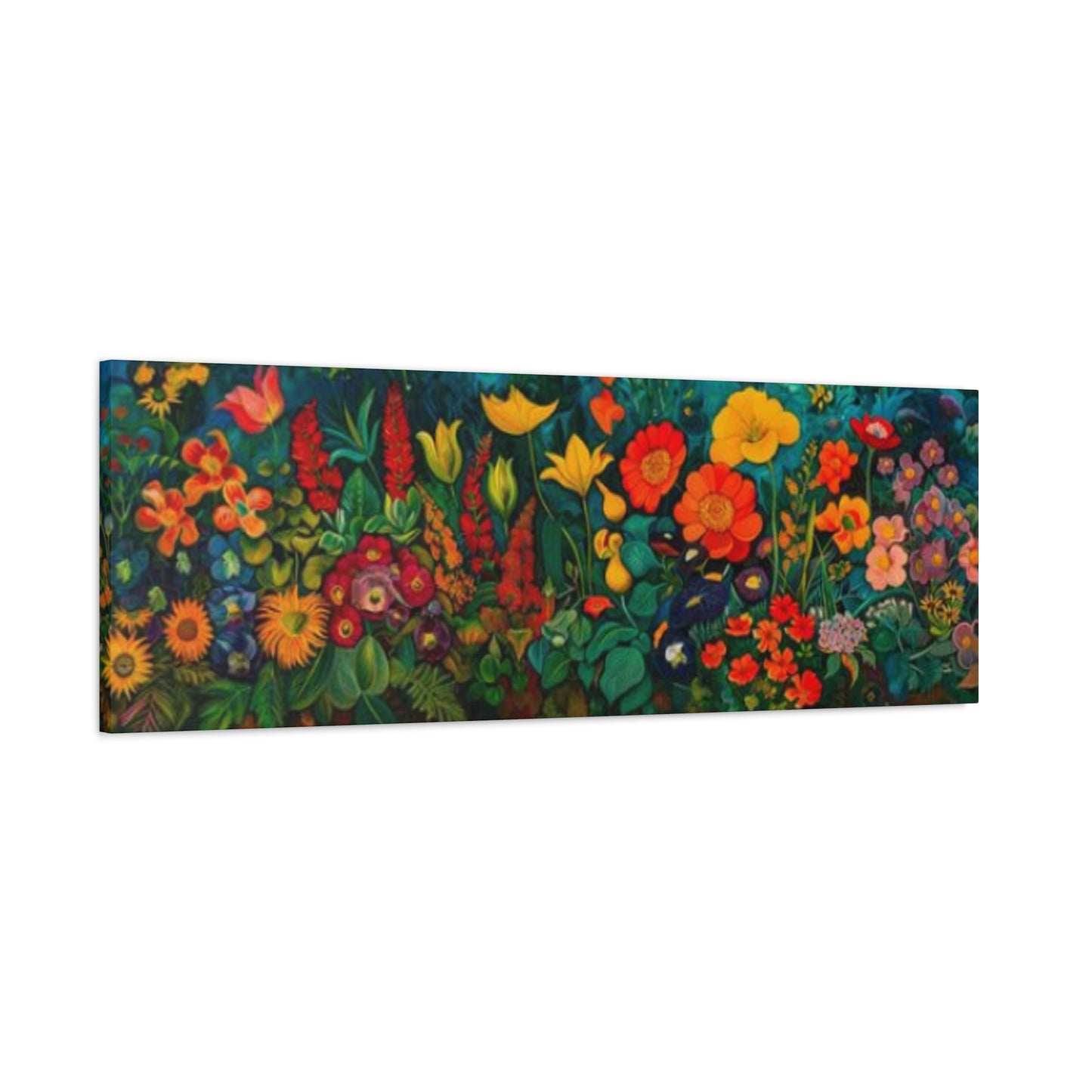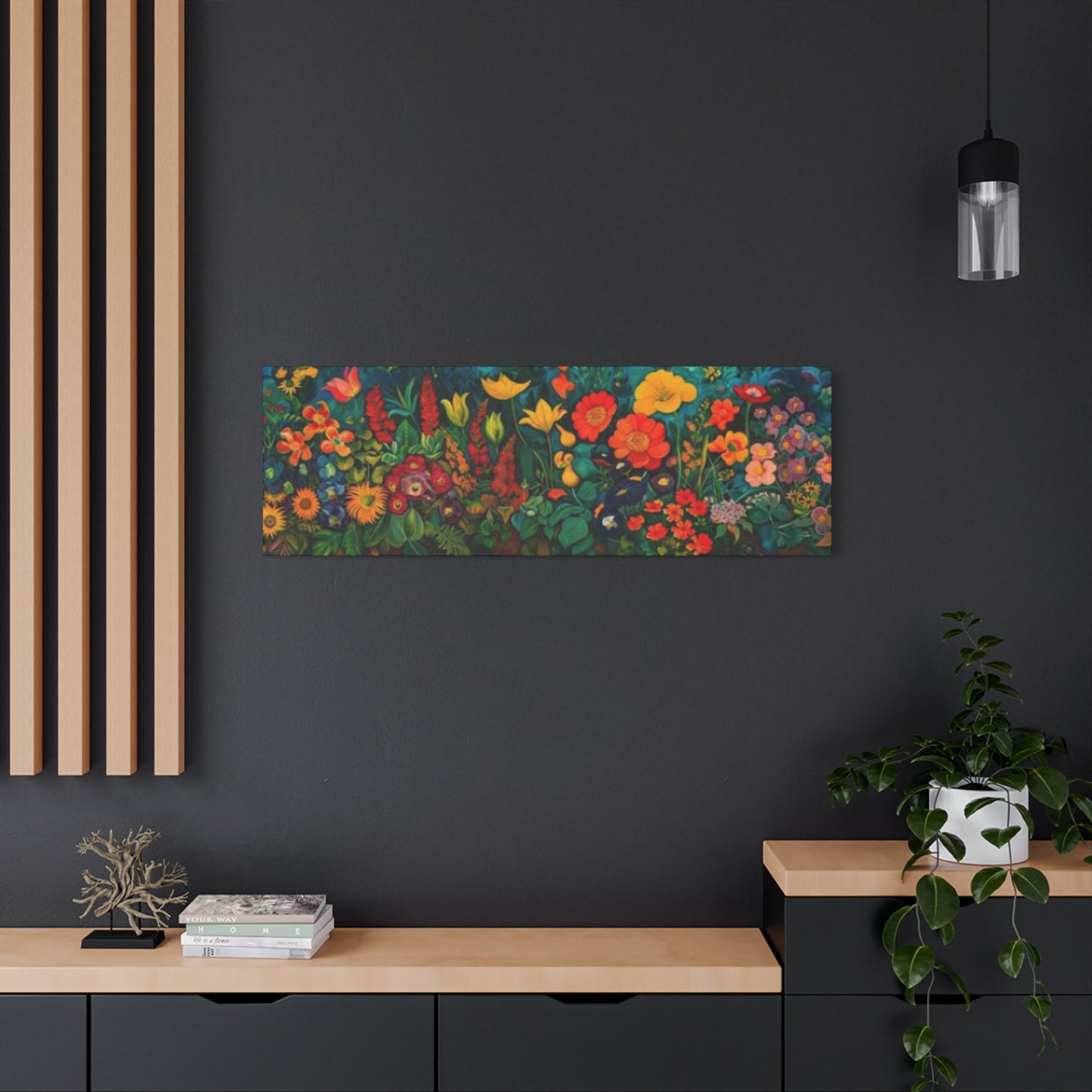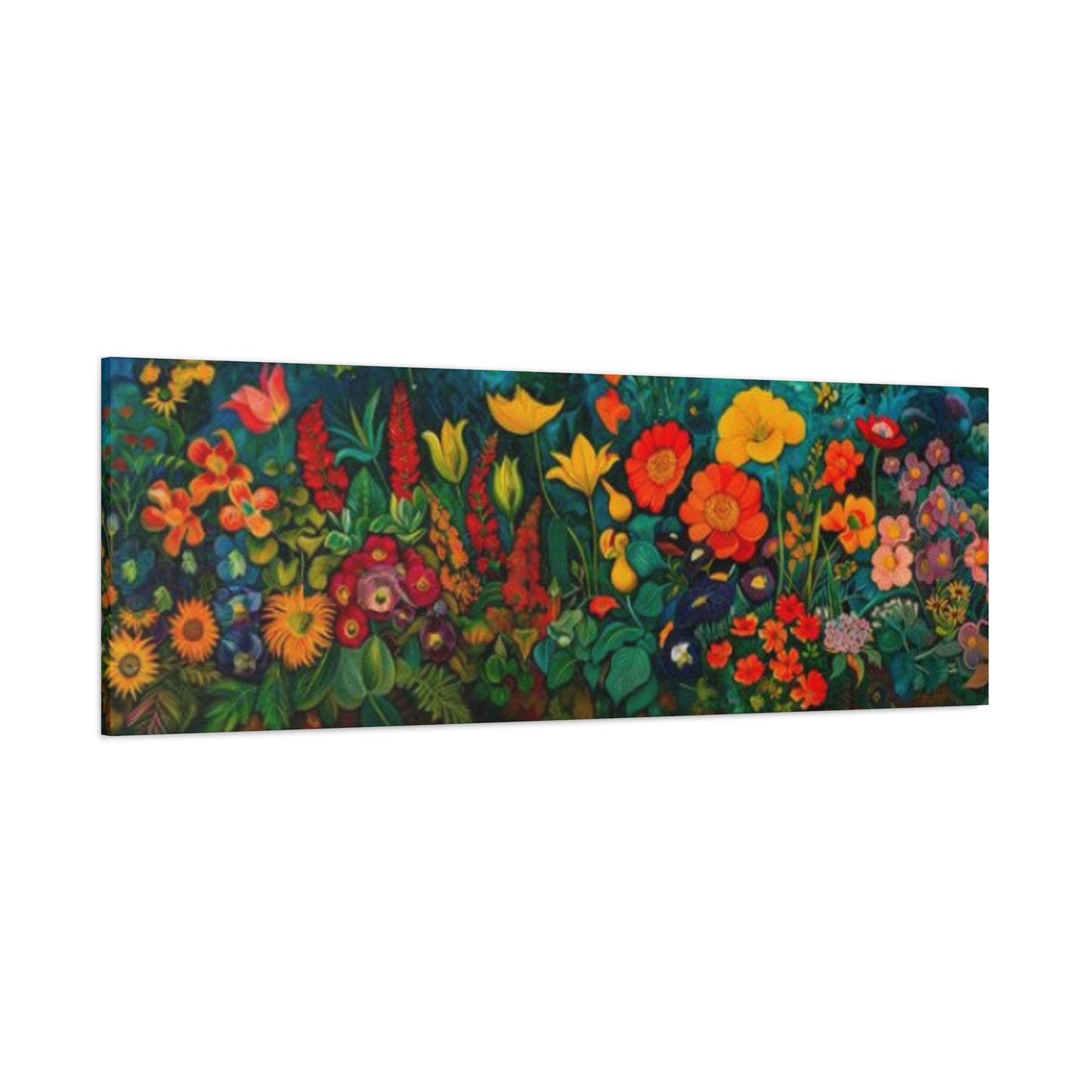Ultimate Guide to Floral Panorama Wall Art: Transforming Your Space with Nature's Artistry
In the world of interior design, few elements possess the timeless appeal and transformative power of floral art. Flowers, in their infinite variety of shapes, colors, and forms, speak a universal language of beauty, life, and emotion. When this natural elegance is captured in a panoramic format—a wide, sweeping vista of botanical splendor—it creates a statement piece that can redefine a room, evoke powerful feelings, and turn a blank wall into a breathtaking focal point.
The panoramic perspective offers a unique, immersive experience. It mimics the natural way our eyes scan a horizon, drawing us into a field of lavender, across a row of vibrant tulips, or deep into the heart of a lush, blooming garden. This elongated format is not just a stylistic choice; it's a tool that can alter the perceived dimensions of a space, create a sense of movement, and tell a more expansive story than a traditional square or portrait-oriented piece.
This comprehensive guide will explore every facet of incorporating floral panoramic prints into your life and home. We will journey through the process of selecting the perfect piece that resonates with your soul, finding the ideal frame to elevate its beauty, and mastering the art of placement. We'll delve into the psychology of color, uncover the hidden meanings behind different blossoms, and offer ideas for every style, budget, and space. Whether you are looking to create a serene sanctuary, a vibrant and energetic hub, or a sophisticated professional environment, the perfect floral panorama is waiting to be discovered. Join us as we explore how to harness the wow-factor of these magnificent prints to brighten your home and inspire your daily life.
Floral Panorama Prints That Wow Every Time
What gives a piece of art that undeniable "wow" factor? It's a combination of scale, subject, color, and emotional resonance. Floral panorama prints are uniquely positioned to deliver this impact in spades. Their power lies in their ability to command attention and transport the viewer, creating an experience that is both visually stunning and deeply felt.
The first element contributing to their wow factor is scale and proportion. The panoramic format is inherently dramatic. Its width-to-height ratio is cinematic, designed to fill one's field of vision. When a wall is graced with a panoramic view of a sun-drenched poppy field or a misty mountain range dotted with wildflowers, it does more than just decorate the space; it fundamentally alters it. This grand scale creates an immersive quality, making you feel as if you could step right into the scene. It’s an architectural element in its own right, capable of elongating a room or adding a sense of grandeur to an otherwise ordinary wall.
Secondly, the subject matter itself is universally captivating. Flowers are nature's masterpieces. A panoramic print can capture this beauty in breathtaking detail. Consider the different styles that produce this "wow" effect:
-
Macro Photographic Panoramas: These pieces zoom in on the intricate details of a line of flowers, like the delicate veins on a row of orchid petals or the glistening dewdrops on a series of rosebuds. The panoramic format allows for a rhythmic repetition of these details, creating a pattern that is both organic and mesmerizingly complex. The sheer clarity and larger-than-life presentation of such familiar objects make us see them in a new, awe-inspiring light.
-
Impressionistic Painted Panoramas: Inspired by artists like Monet, these panoramas focus on light, color, and movement rather than precise detail. A sweeping brushstroke-laden view of a water lily pond or a vibrant, abstracted garden feels dynamic and alive. The energy is palpable. The "wow" comes from the artist's emotional interpretation of the scene, rendered on a grand scale that washes over the viewer.
-
Expansive Landscape Panoramas: These are perhaps the most classic examples. Think of the iconic lavender fields of Provence, the tulip fields of the Netherlands, or the rolling hills of California covered in superblooms. These images evoke a sense of freedom, abundance, and natural wonder. Hanging one in your home is like installing a window to a perfect, idyllic world.
Finally, the use of color is a critical component. A panoramic format provides a vast canvas for a riot of color or a subtle, monochromatic gradient. A print bursting with the reds, oranges, and yellows of a wildflower meadow can inject pure energy and joy into a room. Conversely, a panorama of soft, white cherry blossoms against a pale blue sky can create an atmosphere of profound peace and tranquility. The sheer amount of color presented in the panoramic shape amplifies its psychological impact, making the "wow" not just a visual reaction, but an emotional one as well.
Brighten Your Home with Panoramic Flower Art
Every home can benefit from a dose of brightness and life, and panoramic flower art is one of the most effective ways to achieve this. It’s a design solution that works on multiple levels, influencing the light, mood, and overall energy of a space. More than just a decorative item, it's an infusion of nature's inherent optimism.
The most direct way floral panoramas brighten a home is through color and light. Art featuring flowers like sunflowers, daffodils, yellow tulips, or vibrant zinnias is saturated with warm, sunny hues. These colors are known to trigger feelings of happiness, warmth, and positivity. When displayed in a large panoramic format, these colors become a dominant feature of the room's palette. In a space that lacks natural light, such as a hallway, basement, or north-facing room, a bright floral panorama can act as a visual substitute for a window, creating an illusion of light and openness. The art itself seems to radiate warmth, lifting the ambient mood of the entire area.
Beyond literal color, these prints bring the outdoors in, a core principle of biophilic design. Biophilia is the innate human tendency to connect with nature. Studies have shown that incorporating natural elements and images of nature into our indoor environments can reduce stress, improve cognitive function, and enhance creativity and well-being. A panoramic print of a lush garden or a field of flowers is a powerful biophilic element. It provides a constant, calming connection to the natural world, which is especially vital in urban settings or during long winter months. This connection inherently "brightens" our mental and emotional state, making our home feel more like a sanctuary and less like a container.
The horizontal sweep of a panorama also affects how we perceive a room’s energy. The elongated shape encourages the eye to move, creating a sense of flow and dynamism. A panoramic image of flowers swaying in a gentle breeze, for instance, can introduce a feeling of soft, organic movement into a static room. This visual flow prevents a space from feeling stagnant, making it seem more alive and vibrant. It can guide guests through a space, lead their eyes toward a beautiful view, or simply provide a pleasant visual journey as they relax on the sofa.
To maximize the brightening effect, consider the art's placement in relation to light sources. Hanging a vibrant floral print where it can be touched by natural morning light can make the colors pop and feel even more lively. In the evening, a well-placed picture light can turn the artwork into a luminous focal point, providing a warm, inviting glow that brightens the room long after the sun has set. By thoughtfully choosing and placing panoramic flower art, you are not just decorating; you are actively curating a brighter, happier, and more life-affirming atmosphere for your home.
Choosing the Right Flower Art for Your Wall
Selecting a piece of art is a deeply personal process, but when it comes to a statement piece like a floral panorama, a few practical considerations can ensure you find the perfect match for your wall and your style. The goal is to choose a piece that not only looks beautiful but also harmonizes with its surroundings and reflects your personality. Here is a step-by-step guide to making the right choice.
1. Analyze Your Space and Wall:
-
Size and Scale: The first rule of panoramic art is to respect the scale of the wall. A massive panorama will overwhelm a small wall, while a small one will get lost on a large, empty expanse. Measure your wall space carefully. A general guideline is that the art should occupy between two-thirds and three-fourths of the width of the furniture it hangs above (like a sofa or headboard) or the wall space it is intended to fill. For a long, empty hallway, the panorama can be much longer to match the architectural proportions.
-
Room Function: Consider the purpose of the room. For a bedroom, you might want a calming and serene panorama—think soft-focus lavender fields, cherry blossoms, or watercolor peonies in pastel shades. For a living room or dining area where you entertain, you might opt for something more vibrant and dramatic, like a bold depiction of tropical flowers or a rich, colorful meadow, to spark conversation. In a home office, a print that inspires creativity and focus, such as a field of sunflowers or a clean botanical illustration, could be ideal.
2. Define Your Existing Color Palette:
-
Complementary Approach: Look at the dominant colors in your room (walls, furniture, rugs, curtains). You can choose a floral panorama that incorporates these existing colors. This creates a cohesive, harmonious look where the art feels like a natural extension of the décor. For example, if your room has blue accents, a panorama featuring blue hydrangeas or delphiniums would tie everything together beautifully.
-
Contrast Approach: Alternatively, you can use the art to introduce a bold accent color. In a neutral room of grays, beiges, and whites, a panoramic print bursting with fiery red poppies or deep purple irises can create a stunning focal point and inject a dose of personality and energy. This is a powerful way to make a design statement.
3. Consider Your Personal Style:
-
Modern and Minimalist: If your home has clean lines and a minimalist aesthetic, look for abstract florals, monochromatic pieces, or macro photography with a simple composition and a lot of negative space.
-
Traditional and Classic: For a more traditional interior, an impressionistic painting of a classic English garden or a realistic, detailed botanical panorama would feel right at home. Ornate frames can further enhance this style.
-
Bohemian and Eclectic: Boho styles embrace color, pattern, and a free-spirited vibe. A vibrant, slightly wild depiction of a wildflower field or a richly detailed tropical jungle scene would be a perfect fit.
-
Farmhouse and Rustic: For this cozy, rustic aesthetic, consider panoramas of sunflowers, lavender, or daisies in a field setting. Art with a slightly weathered or vintage feel can also work beautifully.
4. Think About the Mood You Want to Create:
Art is an emotional investment. How do you want to feel when you look at it?
-
Calm and Serene: Look for soft palettes, misty scenes, and flowers associated with peace, like lilies and lotus flowers.
-
Joyful and Energetic: Choose bright, bold colors, sunny landscapes, and flowers that evoke happiness, such as daisies and sunflowers.
-
Sophisticated and Elegant: Opt for flowers like orchids, calla lilies, or dark, moody roses. A black-and-white or sepia-toned panorama can also exude sophistication.
By thoughtfully working through these steps—analyzing your space, palette, style, and desired mood—you can move beyond simply liking a piece of art to confidently choosing the right floral panorama that will truly complete your room.
Best Frames for Panoramic Flower Paintings
The frame is the final touch that can make or break the presentation of your panoramic flower art. It does more than just protect the print; it defines its edges, complements its style, and integrates it with the surrounding décor. Choosing the right frame for a panoramic piece is especially important, as the frame's lines will be long and prominent. The goal is to enhance the artwork, not overpower it.
1. The Minimalist Approach: The Floater Frame
For modern canvas prints, the floater frame is an exceptionally elegant choice. This style of frame has a small gap between the outer edge of the canvas and the inner edge of the frame, creating the illusion that the artwork is "floating" within it.
-
Why it works: It provides a clean, crisp, gallery-quality finish without distracting from the art itself. The shadow line created by the gap adds depth and sophistication.
-
Best for: Modern, abstract, or photographic floral panoramas on canvas. It’s perfect for minimalist and contemporary interiors where the art is the hero.
-
Color Choices: Black floater frames create a strong, defined border. White frames can blend seamlessly with light-colored walls, making the art pop. Natural wood tones (like maple or oak) can add a touch of warmth and an organic feel, which works beautifully with floral subjects.
2. The Classic Choice: Traditional Wood Frames
Wood frames are timeless and versatile, offering a wide range of styles, colors, and finishes.
-
Why they work: Wood brings a natural warmth and texture that inherently complements botanical art. The style can be adapted to any décor.
-
Style Options:
-
Simple & Clean: A slim, straight-profile frame in a dark espresso, warm walnut, or light oak finish is a versatile choice that suits most styles.
-
Ornate & Decorative: For traditional or maximalist interiors, a more decorative frame with carved details or a gilded finish can turn the panorama into a truly opulent statement piece. This works well for classical or impressionistic floral paintings.
-
Rustic & Weathered: For farmhouse or coastal décor, a distressed or whitewashed wood frame can add character and a sense of history.
3. The Modern and Sleek: Metal Frames
Metal frames offer a sharp, clean, and contemporary look. They are typically thinner than wood frames, which puts maximum focus on the artwork.
-
Why they work: Their slim profile is ideal for the long, narrow shape of a panorama, providing a subtle, unobtrusive border. They feel polished and industrial.
-
Best for: Photographic prints, abstract florals, and modern graphic illustrations. They are a great match for minimalist, industrial, and mid-century modern décor.
-
Color Choices:
-
Black: A classic, high-contrast choice that makes colors pop.
-
Silver/Brushed Nickel: A cool, sophisticated option that pairs well with blue and purple color palettes.
-
Gold/Brass: Adds a touch of warmth and luxury, perfect for elevating a piece and tying in with other metallic accents in the room.
4. The Frameless Look: Gallery Wrap or Acrylic Mount
Sometimes the best frame is no frame at all. This allows the image to extend to the very edge, creating a seamless, immersive experience.
-
Gallery-Wrapped Canvas: The canvas is stretched around a wooden stretcher frame, with the image continuing around the sides. This is a popular, contemporary look that is clean and ready to hang. It emphasizes the dimensionality of the piece.
-
Face-Mounted Acrylic: For the ultimate in modern, high-gloss presentation, the print is mounted behind a sheet of acrylic. This method enhances color, contrast, and clarity, creating a vibrant, almost luminous effect. It's a frameless, high-impact look perfect for ultra-modern spaces.
A Note on Matting: While matting is common for standard-sized prints, it can be tricky with panoramas due to their custom proportions. If you do opt for a mat, a wide, single mat in a neutral color (white, off-white, or black) is usually the best choice to provide breathing room for the art without making the final framed piece overly bulky.
Ultimately, the best frame is one that feels like a natural conclusion to the artwork, seamlessly connecting it to the wall and the room it inhabits.
Budget-Friendly Floral Panorama Wall Art
Loving the idea of a stunning floral panorama doesn't mean you have to have a massive budget. A statement piece of art is more accessible than ever before, thanks to a variety of modern printing and purchasing options. With a little creativity and savvy shopping, you can find or create a beautiful panoramic piece that looks like a million bucks without costing it.
1. The World of Digital Downloads
This is perhaps the most affordable and flexible option available today.
-
How it works: Platforms like Etsy are treasure troves of digital art. Artists sell high-resolution digital files of their work—photographs, digital paintings, graphic designs—for a very low price. You purchase the file, download it instantly, and then have it printed yourself.
-
The Advantages:
-
Inexpensive: You're only paying for the artist's digital work, which can be as little as a few dollars.
-
Customizable: You have complete control over the size and the material. You can choose to print it on paper, canvas, or even metal, and you can have it printed in the exact panoramic dimensions that fit your wall.
-
Where to Print: You can use online printing services (like Shutterfly, Printful, or FinerWorks) or take the file to a local print shop. Compare prices for the best deal.
2. Print-on-Demand and Big Box Retailers
Websites like Society6, Redbubble, and Art.com, as well as large retailers like IKEA, Wayfair, and Target, offer a vast selection of mass-produced art prints at affordable prices.
-
How it works: These companies hold the rights to print thousands of images. You can browse their extensive catalogs of floral panoramas and order one in a specific size.
-
The Advantages:
-
Convenience: It's a one-stop-shop. You choose the image and size, and it arrives at your door ready to hang.
-
Frequent Sales: These sites almost always have sales, promotions, or coupon codes, so it pays to wait for a discount before purchasing.
-
Variety: The sheer volume of options means you are likely to find a style you love.
3. DIY Creative Solutions
If you have a creative spark, you can make your own panoramic art.
-
Use Your Own Photography: If you're an amateur photographer, you may already have a beautiful shot of a garden or landscape. Many modern smartphones have a "pano" mode that is perfect for this. You can then have your own photo professionally printed on a large canvas.
-
Create a Triptych: A triptych is a single piece of art divided into three separate panels. You can mimic the panoramic effect by buying three identical (or sequential) vertical floral prints and hanging them side-by-side with a small, uniform gap between them. This can often be cheaper than printing one single, oversized piece.
-
Fabric and Tapestries: Look for a beautiful floral fabric or a wall tapestry with a panoramic design. You can stretch the fabric over a simple wooden frame (which you can build yourself) to create a lightweight, inexpensive, and unique piece of canvas-style art.
4. Second-Hand and Thrifting
Don't overlook thrift stores, flea markets, and online marketplaces like Facebook Marketplace. You might find a vintage floral print or painting that someone else is getting rid of. While finding a perfect panorama might be rare, it’s not impossible, and the thrill of the hunt is part of the fun. You could find a unique, character-filled piece for a fraction of its original cost.
With these budget-friendly strategies, a beautiful, wall-transforming floral panorama is well within reach for any art lover.
Creating Calm with Soft Flower Palettes
In our fast-paced, often chaotic world, our homes need to be sanctuaries—places where we can unwind, de-stress, and find peace. The art we choose plays a crucial role in shaping this calming atmosphere. Floral panoramas with soft, gentle color palettes are exceptionally effective at creating a sense of tranquility and serenity.
The Power of a Soft Palette
Soft palettes are characterized by low-saturation colors, pastels, and muted tones. Think of dusty rose, pale lavender, soft sage green, creamy ivory, and hazy sky blue. These colors are gentle on the eyes and have a psychologically soothing effect. They don't demand attention or jolt the senses like bright, primary colors do. Instead, they whisper, creating a background of subtle beauty that promotes relaxation and quiet contemplation.
When this soft color story is applied to a floral subject across a wide panoramic canvas, the calming effect is magnified. The expansive view envelops you in its peacefulness, transforming a room into a restful retreat.
Flowers and Styles for a Serene Aesthetic
Certain flowers and artistic styles naturally lend themselves to a soft, calming aesthetic:
-
Peonies: With their lush, layered petals, peonies are often depicted in soft pinks, whites, and creamy yellows. They symbolize romance and prosperity but also exude a gentle, dreamy quality.
-
Hydrangeas: Known for their large globes of flowers, hydrangeas come in beautiful muted shades of blue, lavender, pink, and antique green. A panorama of hydrangeas can feel like a soft, romantic cloud of color.
-
Baby's Breath (Gypsophila): Delicate and airy, a panoramic close-up of baby's breath can create a minimalist, ethereal effect that is incredibly peaceful.
-
Cherry Blossoms: As mentioned before, the pale pink and white of cherry blossoms against a soft sky is the epitome of gentle, fleeting beauty.
-
Watercolor Style: Art rendered in watercolor naturally has a soft, translucent quality. The way the colors bleed and blend creates a dreamy, fluid look that is perfect for a calming floral scene.
-
Soft-Focus Photography: Photographic prints that use a shallow depth of field, leaving the background softly blurred, draw your attention to the gentle beauty of the main subject while creating an overall hazy, dreamlike mood.
Where to Use Soft Flower Palettes
-
The Bedroom: This is the most obvious and effective place. A calming panorama above the bed can help you unwind at the end of the day and set a peaceful tone for sleep.
-
The Bathroom: Transform your bathroom into a spa-like oasis with a serene floral print. Paired with soft towels and calming scents, it can make your daily routines feel more like a ritual of self-care.
-
A Reading Nook: In a quiet corner dedicated to reading and relaxing, a soft floral panorama can enhance the sense of escape and tranquility.
-
A Nursery or Child's Room: A gentle floral print can create a sweet, soothing environment for a little one.
By intentionally choosing a floral panorama with a soft, muted palette, you are making a powerful design choice to prioritize peace. You are curating not just a beautiful room, but a personal sanctuary designed to soothe the soul.
Flower Art That Matches Any Season
While it can be fun to rotate art seasonally, many people prefer to invest in a statement piece that feels appropriate and beautiful all year round. The key to finding a seasonless floral panorama is to choose subjects, styles, and color palettes that aren't strongly tied to a specific time of year like spring's tulips or autumn's mums.
1. Focus on Botanical Illustrations
A classic botanical illustration style is timeless and seasonless. These pieces often feature a variety of flowers and foliage arranged artfully against a neutral, plain background (typically white, cream, or black).
-
Why it works: By removing the flower from its natural landscape (a snowy field or a sun-drenched meadow), the art becomes a scientific and aesthetic study of the plant itself. The focus is on the form, color, and detail of the blossoms, which are beautiful in their own right, regardless of the season outside your window. A panoramic arrangement of various ferns, wildflowers, and herbs can look fresh in spring, lush in summer, rich in autumn, and provide a welcome touch of green in winter.
2. Choose a Seasonally Ambiguous Landscape
Some floral landscapes don't scream a particular season.
-
Wildflower Meadows: A vibrant meadow with a mix of flowers like poppies, cornflowers, daisies, and lavender can feel just as appropriate on a bright summer day as it does as a cheerful reminder of warmth in the depths of winter. The sheer variety of blooms prevents it from being pinned down to one specific blooming period.
-
Misty or Foggy Scenes: A panoramic photograph of a flower field shrouded in morning mist or fog has a moody, atmospheric quality that transcends seasons. The soft, diffused light feels calm and mysterious and works beautifully year-round, feeling cool and refreshing in the summer and cozy and contemplative in the winter.
3. Opt for a Monochromatic or Neutral Palette
Color is one of the biggest seasonal indicators. Bright pastels say "spring," while deep oranges and burgundies say "autumn." By removing or neutralizing the color, the art becomes season-agnostic.
-
Black and White or Sepia: A stunning black-and-white panoramic photograph of a field of flowers focuses entirely on shape, texture, contrast, and light. It is a sophisticated, classic, and endlessly versatile choice that will complement any décor in any season. Sepia tones can give a similar effect but with a warmer, vintage feel.
-
Neutral-Toned Paintings: An abstract or impressionistic painting that uses a palette of beiges, grays, creams, and soft, muted earth tones can suggest a floral landscape without being explicit. This allows it to blend seamlessly with your décor throughout the year.
4. Select "Evergreen" Flowers
Some flowers, especially those commonly grown in greenhouses or tropical climates, don't have a strong seasonal association in many people's minds.
-
Orchids: These elegant, exotic flowers are available year-round and are associated with luxury and beauty rather than a specific season. A simple, elegant panorama of a branch of orchids is timeless.
-
Tropical Flowers: In non-tropical climates, flowers like hibiscus or birds of paradise evoke a feeling of "vacation" and "warmth" rather than a specific local season. They can be a welcome splash of exotic beauty at any time.
By choosing a floral panorama with one of these versatile characteristics, you can invest in a piece of art that you will love and that will enhance your home's beauty every single day of the year.
How to Clean and Care for Wall Art
Investing in a beautiful piece of floral panoramic art means you'll want to keep it looking its best for years to come. Proper cleaning and care are essential, but they are also simple and require a gentle touch. The correct method depends entirely on the type of art you have. Using the wrong technique can cause irreparable damage.
For Framed Prints Under Glass or Acrylic (Plexiglass)
This is the easiest type of art to clean, as the glass or acrylic provides a protective barrier for the print itself.
-
Dusting: Regular dusting is the most important step. Use a soft, dry microfiber cloth or a feather duster to gently wipe the surface and the frame. This prevents dust from building up and working its way inside the frame.
-
Cleaning Smudges: For fingerprints or smudges, lightly spray a small amount of glass cleaner onto a clean microfiber cloth—never spray directly onto the art. Spraying directly on the surface can cause the cleaner to seep under the edges of the frame and damage the print or mat. Gently wipe the glass or acrylic in a circular motion and then dry with a separate clean, dry cloth.
-
Important Note for Acrylic: If your frame has acrylic instead of real glass, do NOT use cleaners containing ammonia (like Windex), as they can cloud the acrylic over time. Use a cleaner specifically designed for acrylic or a simple solution of mild soap and water.
For Canvas Prints (Gallery-Wrapped or Framed)
Canvas prints, which don't have a protective glass layer, require a more delicate approach.
-
Dusting: This is your primary cleaning tool. Use a very soft, dry, clean paintbrush or a feather duster to gently whisk away dust from the surface of the canvas. Be very gentle and avoid applying pressure. Do not use a microfiber cloth, as its fibers can catch on the texture of the canvas or any raised paint/ink.
-
Spot Cleaning (Use with Extreme Caution): If there is a small, specific spot or smudge, you can try to clean it, but always test on an inconspicuous area first (like the very edge or corner). Lightly dampen a soft, white cotton cloth with water. Wring it out thoroughly so it is almost dry. Very gently dab—do not rub—the affected area. Rubbing can lift the ink or paint from the canvas. For most canvas prints, it's best to avoid any moisture at all if possible.
-
What to Avoid: NEVER use chemical cleaners, solvents, or even mild soap on a canvas print. These will strip the color and damage the protective varnish.
General Care and Preservation Tips for All Wall Art
-
Avoid Direct Sunlight: UV rays are the number one enemy of art. Direct sunlight will cause the colors in your print or painting to fade dramatically over time. Hang your art on a wall that does not receive long hours of direct, harsh sunlight.
-
Control Humidity: Extreme fluctuations in humidity can damage art. In very damp environments, canvas can sag, and paper can ripple or develop mold. In very dry environments, wood frames can become brittle. Try to maintain a stable, moderate humidity level in your home. Avoid hanging valuable art in bathrooms or basements with poor ventilation.
-
Handle with Care: When moving or hanging your art, make sure your hands are clean and dry to avoid transferring oils to the surface. Handle the piece by its frame or edges.
-
Check the Hardware: Periodically check that the hanging wire and hooks are still secure, especially for large, heavy pieces.
With just a few minutes of regular, gentle maintenance, your floral panorama will remain a vibrant and beautiful focal point in your home for a lifetime.
Floral Panoramas for Office or Studio Walls
The environments where we work have a profound impact on our productivity, creativity, and overall well-being. A sterile, uninspired office can lead to creative blocks and low morale. Incorporating art, specifically a beautiful floral panorama, is a powerful and effective way to transform a professional workspace into a place that fosters inspiration, reduces stress, and communicates a positive brand identity.
Boosting Creativity and Reducing Stress
As discussed under the principle of biophilia, exposure to images of nature has been scientifically shown to have a restorative effect on the mind.
-
For Creativity: In a creative studio—for a graphic designer, writer, or artist—a floral panorama can serve as a source of inspiration. An abstract floral with a dynamic color palette might spark new ideas. A detailed macro photograph could inspire an appreciation for pattern and texture. The art provides a "mental palate cleanser," a beautiful vista to gaze at when feeling stuck, allowing the mind to wander and form new connections.
-
For Stress Reduction: In a high-pressure office environment—like a law firm, a financial consultancy, or a busy corporate headquarters—a calming floral panorama can have a tangible impact on employee well-being. A serene image of a misty garden or a peaceful lavender field in a reception area or break room can help lower stress levels for both employees and visiting clients. It creates an atmosphere of calm competence and care.
Enhancing the Professional Image
The art on your office walls says a lot about your company's culture and values.
-
Sophistication and Elegance: A sleek panorama of white orchids or calla lilies against a dark background can convey a sense of luxury, precision, and high-end service. This would be perfect for a boutique consulting firm, a high-end salon, or a real estate office.
-
Growth and Vitality: An image of a lush, thriving garden or a field of sunflowers can symbolize growth, optimism, and success. This is a great message for a startup, a financial growth company, or a healthcare provider's office.
-
Welcoming and Approachable: A cheerful panorama of a wildflower meadow in a reception area can make a company feel more welcoming, human, and down-to-earth. This is ideal for a therapist's office, a non-profit organization, or a family-focused business.
Practical Considerations for Office Spaces
-
Scale: In a large corporate lobby or a long hallway, you have the opportunity to go big. A massive, wall-sized panorama can make an unforgettable first impression on visitors and clients.
-
Style: The style of the art should align with the company's branding. A tech startup might opt for a modern, abstract floral, while a more traditional institution might prefer a classic impressionistic painting.
-
Placement:
-
Reception Area: This is a prime location to set the tone for your business.
-
Conference Rooms: A beautiful piece of art can make long meetings more pleasant and can be a point of visual interest during breaks in discussion.
-
Individual Offices: Allowing employees to choose (or providing a selection of) art for their own offices can boost morale and allow for personalization of their workspace.
-
Break Rooms: This is a space for relaxation and recharging, making a calming floral scene an ideal choice.
By investing in thoughtful art like a floral panorama, a business is investing in its people and its brand, creating a workspace that is not only more beautiful but also more productive, creative, and humane.
Conclusion:
From the grand, cinematic sweep that can redefine a living room to the gentle, calming palette that can turn a bedroom into a sanctuary, floral panoramic prints offer a world of decorative and emotional possibilities. We have journeyed through the myriad ways these stunning pieces can transform a space, exploring how their scale, color, and symbolism can be harnessed to craft an environment that is not just aesthetically pleasing, but also deeply resonant with our personal style and emotional needs.
We've seen that the power of a floral panorama lies in its unique ability to be both a window and a mirror—a window to an idyllic natural world that brings light, life, and a sense of expansiveness indoors, and a mirror reflecting our own desire for beauty, tranquility, or joyful energy. Whether you are drawn to the meticulous detail of a realistic photograph, the emotional energy of an abstract painting, the timeless elegance of a botanical illustration, or the romantic charm of an impressionistic landscape, there is a floral panorama to match every taste and every home.
The journey of choosing art for your home is a personal one. It is an opportunity to express who you are and to curate the feeling of the spaces where you live, work, and dream. Let this guide be your starting point. Be bold in your choices, trust your instincts, and don't be afraid to let a single, magnificent piece of art become the soul of your room. By embracing the panoramic perspective, you can turn any empty wall into an immersive experience, a daily dose of nature's poetry that will wow you, and your guests, every single time.














